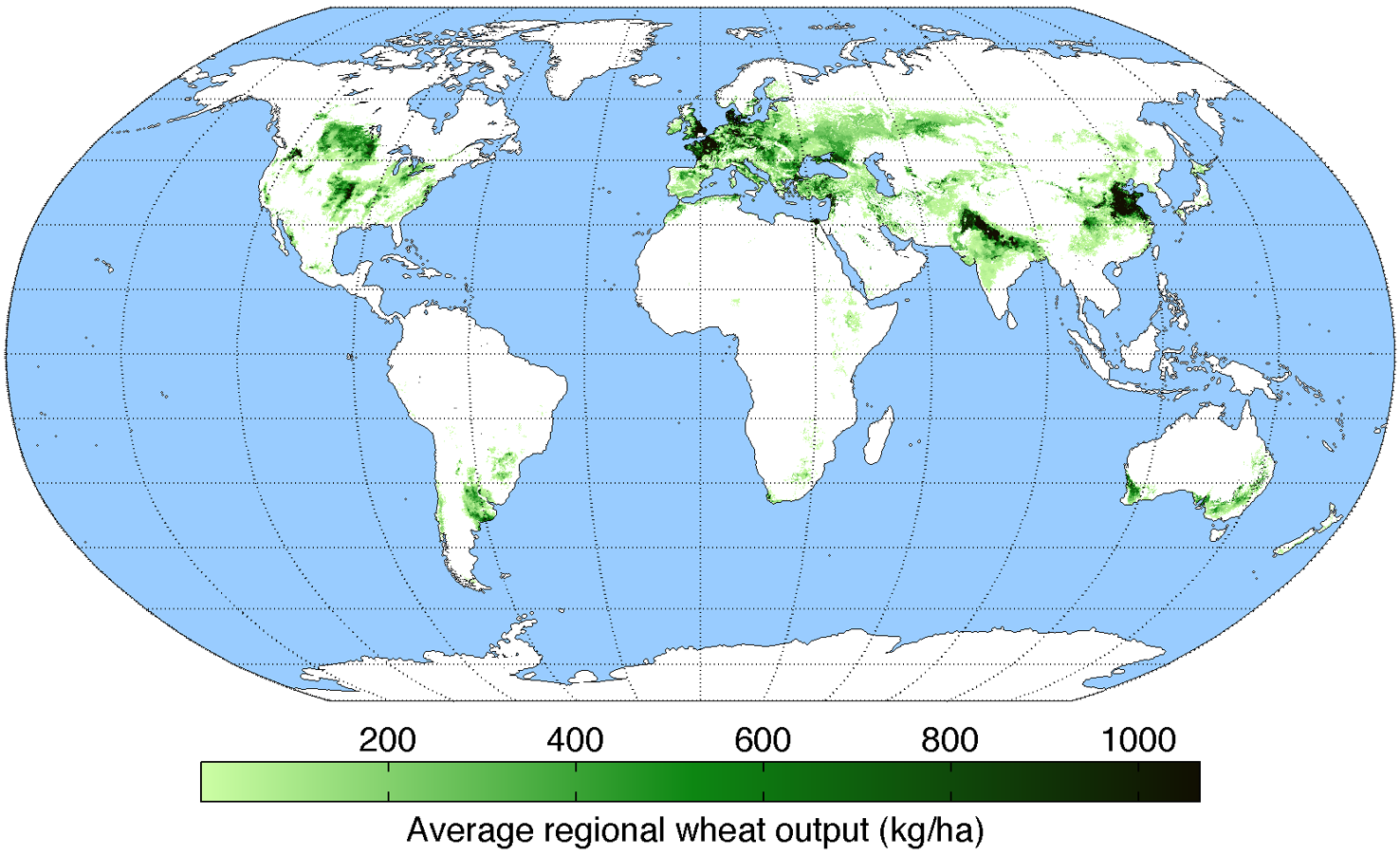|
Wheat And Chessboard Problem
The wheat and chessboard problem (sometimes expressed in terms of rice grains) is a mathematical problem expressed in word problem (mathematics education), textual form as: The problem may be solved using simple addition. With 64 squares on a chessboard, if the number of grains doubles on successive squares, then the sum of grains on all 64 squares is: and so forth for the 64 squares. The total number of grains can be shown to be 264−1 or 18,446,744,073,709,551,615 (eighteen Names of large numbers#Standard dictionary numbers, quintillion, four hundred forty-six quadrillion, seven hundred forty-four trillion, seventy-three billion, seven hundred nine million, five hundred fifty-one thousand, six hundred and fifteen). This exercise can be used to demonstrate how quickly exponential sequences grow, as well as to introduce exponents, zero power, capital-sigma notation, and geometric series. Updated for modern times using pennies and a hypothetical question such as "Would you ... [...More Info...] [...Related Items...] OR: [Wikipedia] [Google] [Baidu] |
Billions And Billions
''Billions and Billions: Thoughts on Life and Death at the Brink of the Millennium'' is a 1997 book by the American astronomer and science popularizer Carl Sagan. The last book written by Sagan before his death in 1996, it was published by Random House. Overview The book is a collection of essays Sagan wrote covering diverse topics such as global warming, the population explosion, extraterrestrial life, morality, and the abortion debate. The last chapter is an account of his struggle with myelodysplasia, the disease which finally took his life in December 1996. Sagan's wife, Ann Druyan, wrote the epilogue of the book after his death. "Billions and billions" To help viewers of ''Cosmos'' distinguish between "millions" and "billions", Sagan stressed the "b". The public's association of Sagan with the phrase " billions and billions" came from a ''Tonight Show'' skit. Parodying Sagan's affect, Johnny Carson quipped "billions and billions". [...More Info...] [...Related Items...] OR: [Wikipedia] [Google] [Baidu] |
Carl Sagan
Carl Edward Sagan (; ; November 9, 1934December 20, 1996) was an American astronomer, planetary scientist and science communicator. His best known scientific contribution is his research on the possibility of extraterrestrial life, including experimental demonstration of the production of amino acids from basic chemicals by exposure to light. He assembled the first physical messages sent into space, the Pioneer plaque and the Voyager Golden Record, which were universal messages that could potentially be understood by any Extraterrestrial life, extraterrestrial intelligence that might find them. He argued in favor of the hypothesis, which has since been accepted, that the high surface temperatures of Venus are the result of the greenhouse effect.Extract of page 14 Initially an assistant professor at Harvard Universi ... [...More Info...] [...Related Items...] OR: [Wikipedia] [Google] [Baidu] |
International Wheat Production Statistics
The following international wheat production statistics come from the Food and Agriculture Organization figures from FAOSTAT database, older from International Grains Council figures from the report "Grain Market Report". The quantities of wheat in the following table are in million metric tonnes. All countries with a typical production quantity of at least 2 million metric tonnes are listed below. References {{DEFAULTSORT:International Wheat Production Statistics Wheat Wheat Wheat is a group of wild and crop domestication, domesticated Poaceae, grasses of the genus ''Triticum'' (). They are Agriculture, cultivated for their cereal grains, which are staple foods around the world. Well-known Taxonomy of wheat, whe ... *Wheat ... [...More Info...] [...Related Items...] OR: [Wikipedia] [Google] [Baidu] |
Metric Tons
The tonne ( or ; symbol: t) is a unit of mass equal to 1,000 kilograms. It is a non-SI unit accepted for use with SI. It is also referred to as a metric ton in the United States to distinguish it from the non-metric units of the short ton (United States customary units) and the long ton ( British imperial units). It is equivalent to approximately 2,204.6 pounds, 1.102 short tons, and 0.984 long tons. The official SI unit is the megagram (Mg), a less common way to express the same amount. Symbol and abbreviations The BIPM symbol for the tonne is t, adopted at the same time as the unit in 1879.Table 6 . BIPM. Retrieved on 2011-07-10. Its use is also official for the metric ton in the United States, having been adopted by the United States |
Raymond Kurzweil
Raymond Kurzweil ( ; born February 12, 1948) is an American computer scientist, author, entrepreneur, futurist, and inventor. He is involved in fields such as optical character recognition (OCR), text-to-speech synthesis, speech recognition technology and electronic keyboard instruments. He has written books on health technology, artificial intelligence (AI), transhumanism, the technological singularity, and futurism. Kurzweil is a public advocate for the futurist and transhumanist movements and gives public talks to share his optimistic outlook on life extension technologies and the future of nanotechnology, robotics, and biotechnology. Kurzweil received the 1999 National Medal of Technology and Innovation, the United States' highest honor in technology, from President Bill Clinton in a White House ceremony. He received the $500,000 Lemelson–MIT Prize in 2001. He was elected a member of the National Academy of Engineering in 2001 for the application of technology to improve ... [...More Info...] [...Related Items...] OR: [Wikipedia] [Google] [Baidu] |
Technology Strategy
Technology strategy (information technology strategy or IT strategy) is the overall plan which consists of objectives, principles and tactics relating to use of technologies within a particular organization. Such strategies primarily focus on the technologies themselves and in some cases the people who directly manage those technologies. The strategy can be implied from the organization's behaviors towards technology decisions, and may be written down in a document. The strategy includes the formal vision that guides the acquisition, allocation, and management of IT resources so it can help fulfill the organizational objectives. Other generations of technology-related strategies primarily focus on: the efficiency of the company's spending on technology; how people, for example the organization's customers and employees, exploit technologies in ways that create value for the organization; on the full integration of technology-related decisions with the company's strategies and oper ... [...More Info...] [...Related Items...] OR: [Wikipedia] [Google] [Baidu] |
Wheat Chessboard With Line
Wheat is a group of wild and domesticated grasses of the genus ''Triticum'' (). They are cultivated for their cereal grains, which are staple foods around the world. Well-known wheat species and hybrids include the most widely grown common wheat (''T. aestivum''), spelt, durum, emmer, einkorn, and Khorasan or Kamut. The archaeological record suggests that wheat was first cultivated in the regions of the Fertile Crescent around 9600 BC. Wheat is grown on a larger area of land than any other food crop ( in 2021). World trade in wheat is greater than that of all other crops combined. In 2021, world wheat production was , making it the second most-produced cereal after maize (known as corn in North America and Australia; wheat is often called corn in countries including Britain). Since 1960, world production of wheat and other grain crops has tripled and is expected to grow further through the middle of the 21st century. Global demand for wheat is increasing because of the use ... [...More Info...] [...Related Items...] OR: [Wikipedia] [Google] [Baidu] |
Mersenne Number
In mathematics, a Mersenne prime is a prime number that is one less than a power of two. That is, it is a prime number of the form for some integer . They are named after Marin Mersenne, a French Minim friar, who studied them in the early 17th century. If is a composite number then so is . Therefore, an equivalent definition of the Mersenne primes is that they are the prime numbers of the form for some prime . The exponents which give Mersenne primes are 2, 3, 5, 7, 13, 17, 19, 31, ... and the resulting Mersenne primes are 3, 7, 31, 127, 8191, 131071, 524287, 2147483647, ... . Numbers of the form without the primality requirement may be called Mersenne numbers. Sometimes, however, Mersenne numbers are defined to have the additional requirement that should be prime. The smallest composite Mersenne number with prime exponent ''n'' is . Mersenne primes were studied in antiquity because of their close connection to perfect numbers: the Euclid–Euler ... [...More Info...] [...Related Items...] OR: [Wikipedia] [Google] [Baidu] |
Geometric Growth
Exponential growth occurs when a quantity grows as an exponential function of time. The quantity grows at a rate direct proportion, directly proportional to its present size. For example, when it is 3 times as big as it is now, it will be growing 3 times as fast as it is now. In more technical language, its instantaneous Rate (mathematics)#Of change, rate of change (that is, the derivative) of a quantity with respect to an independent variable is proportionality (mathematics), proportional to the quantity itself. Often the independent variable is time. Described as a Function (mathematics), function, a quantity undergoing exponential growth is an Exponentiation#Power functions, exponential function of time, that is, the variable representing time is the exponent (in contrast to other types of growth, such as quadratic growth). Exponential growth is Inverse function, the inverse of logarithmic growth. Not all cases of growth at an always increasing rate are instances of exponenti ... [...More Info...] [...Related Items...] OR: [Wikipedia] [Google] [Baidu] |
Exponential Growth
Exponential growth occurs when a quantity grows as an exponential function of time. The quantity grows at a rate directly proportional to its present size. For example, when it is 3 times as big as it is now, it will be growing 3 times as fast as it is now. In more technical language, its instantaneous rate of change (that is, the derivative) of a quantity with respect to an independent variable is proportional to the quantity itself. Often the independent variable is time. Described as a function, a quantity undergoing exponential growth is an exponential function of time, that is, the variable representing time is the exponent (in contrast to other types of growth, such as quadratic growth). Exponential growth is the inverse of logarithmic growth. Not all cases of growth at an always increasing rate are instances of exponential growth. For example the function f(x) = x^3 grows at an ever increasing rate, but is much slower than growing exponentially. For example, w ... [...More Info...] [...Related Items...] OR: [Wikipedia] [Google] [Baidu] |



